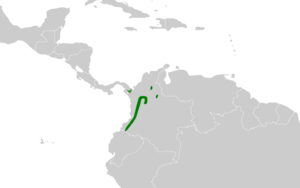Sooty-headed wren facts for kids
Quick facts for kids Sooty-headed wren |
|
|---|---|
 |
|
| A Sooty-headed wren in Colombia | |
| Conservation status | |
| Scientific classification | |
| Genus: |
Pheugopedius
|
| Species: |
spadix
|
 |
|
| Synonyms | |
|
Thryothorus spadix |
|
The sooty-headed wren (Pheugopedius spadix) is a small bird that belongs to the wren family, Troglodytidae. You can find this bird in parts of Colombia and Panama. It's known for its unique look and song.
Contents
About the Sooty-headed Wren
How Scientists Classify This Bird
Scientists group living things to understand them better. The sooty-headed wren was once thought to be the same as another bird, the black-throated wren. However, experts noticed big differences in their feathers, songs, and where they live. Because of these differences, they are now considered separate species.
Some bird groups, like the International Ornithological Committee (IOC), say there is only one type of sooty-headed wren. But other groups, such as the Clements taxonomy and BirdLife International, believe there are two slightly different kinds, called subspecies. These are Pheugopedius spadix spadix and P. s. xerampelinus.
What the Sooty-headed Wren Looks Like
This wren is about 14.5 centimeters (5.7 inches) long. The main type of adult sooty-headed wren has a dull blackish color on its head, shoulders, and back. Its lower back, called the rump, is a bright chestnut brown. Its tail is also chestnut with clear black stripes.
Its face is mostly black with white lines. The chin and throat are black, which stands out against the bright chestnut color of its lower throat and chest. The belly is a duller grayish-brown, and its sides are reddish-brown. Young wrens are not as brightly colored as adults. Their colors are less distinct. The other subspecies, P. s. xerampelinus, is generally lighter in color. It also has less reddish-brown on its sides.
Where the Sooty-headed Wren Lives
The main type of sooty-headed wren lives in Colombia. You can find it in the lowlands near the Pacific Ocean, from the southern Chocó Department to the Nariño Department. It also lives east into the central Magdalena Valley and in some mountain areas. The P. s. xerampelinus subspecies lives on the Pacific side of southern Panama's Darién Province.
This bird likes to live inside and at the edges of wet forests. It also lives in cloudforests and thick secondary forests (forests that have grown back after being cut down). It especially likes places with a lot of moss growing. These wrens usually live at elevations between 800 and 1,800 meters (about 2,600 to 5,900 feet). However, in Colombia, they can sometimes be found as low as 400 meters (about 1,300 feet).
Sooty-headed Wren Behavior
How the Sooty-headed Wren Finds Food
Sooty-headed wrens usually look for food in pairs. They stay low in the plants and trees. They do not often join large groups of different bird species that are foraging together. Sometimes, they follow army ants. These ants move in big groups and stir up insects, which the wrens then catch. The sooty-headed wren mostly eats small animals without backbones, like spiders and insects (both adult insects and their young, called larvae).
Reproduction and Nests
Scientists do not have a lot of information about how the sooty-headed wren breeds. However, it seems their breeding season runs from March to December. Their nest is shaped like a ball. It is made from rough materials and leaves, and it has an entrance on the side.
Sooty-headed Wren Songs
Both male and female sooty-headed wrens sing. Their song is described as "a series of...gurgling whistles." You can listen to their songs online to hear what they sound like.
Sooty-headed Wren Conservation Status
The IUCN (International Union for Conservation of Nature) has looked at the sooty-headed wren. They have decided that it is a species of "Least Concern." This means that the bird is not currently in danger of disappearing. It is "fairly common" in places where it likes to live in Colombia.


